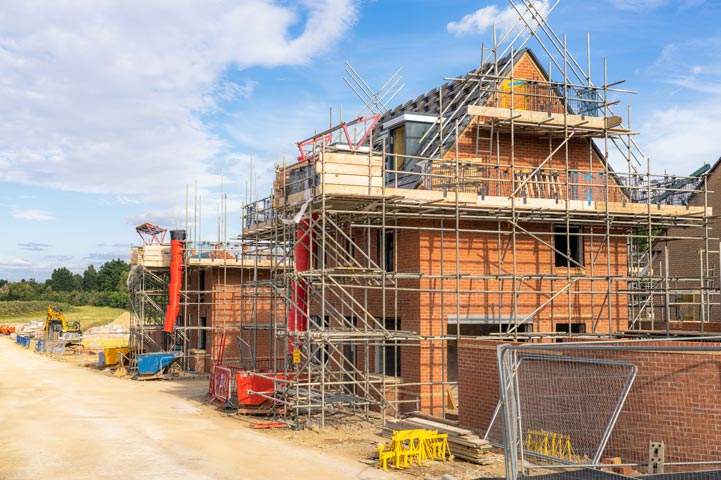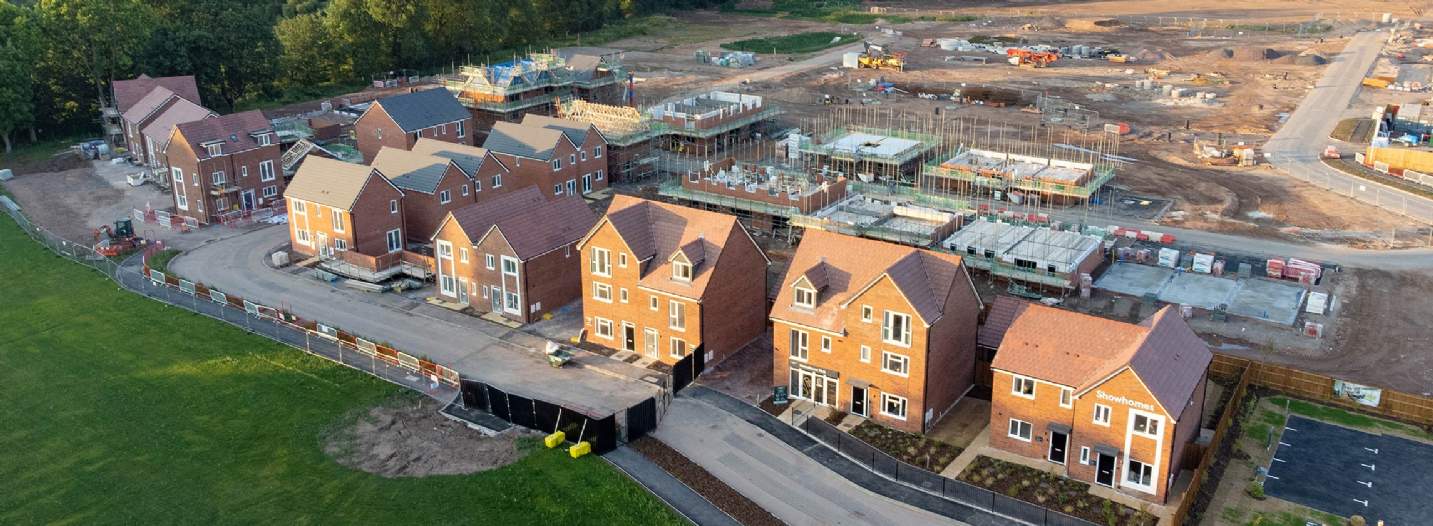Demand improves and prices rise as the housing market begins to recover
House prices in Wales have begun to rise as falling mortgage rates have improved confidence and brought demand back into the sales market. Transactions remain some way below the pre-pandemic average, but a rise in sales agreed suggests activity is growing. Mortgage rates remain high, however, meaning affordability is still stretched. A sustained improvement in demand is therefore still not certain in the short term. In the longer term, affordability constraints should ease, enabling more consistent price growth.
The outlook is very weak for new housing delivery as planning consents have fallen further. But a rise in starts suggests viability may be improving.
Prices rise and forward indicators become more positive
House prices in Wales rose by 1.3% in the year to Q1 2024 and by 1.2% in Q1 alone, according to Nationwide. Demand has begun to return in the last four months, particularly as mortgage rates have eased, leaving prices just -3.6% below their late 2022 peak. Our current forecasts, which suggest prices will fall by -2.0% in Wales in 2024, are likely to be an underestimate. But affordability does remain constrained, and a full market recovery in the short term is conditional on interest rates falling as financial markets expect.
House prices in Wales will outperform the UK average over the next five years at 21.4%, the highest growth expected of any area of the UK. As a falling base rate brings down mortgage rates, affordability will improve. Affordability in Wales is less stretched than elsewhere, suggesting a market recovery can begin earlier.
Annual price growth has varied across Wales. The Land Registry price index is lagged and shows price growth in seven local authorities in the year to November, led by Blaenau Gwent (2.7%) and Ceredigion (1.6%). The largest falls were in Gwynedd (-8.6%) and Merthyr Tydfil (-7.9%).
Transaction activity has been below average for some time, with the shortfall increasing in recent months – the three months to January 2024 saw the fewest transactions in a three-month period since early 2015 (excluding mid-2020). While transactions may remain low in the coming months because of delays in reaching completion, sales agreed have begun to increase, again pointing to a more positive market than in 2023.
Rental growth for all existing tenancies in the year to January has been higher in Wales than any other area of the UK, according to the ONS, at 7.0%. Rents for new lets have increased by 9.5%, according to Zoopla, and by 36% since the pandemic, placing pressure on renters’ finances. The unfreezing of Local Housing Allowance (LHA) from April will provide welcome support for those on the lowest incomes. But our analysis, found here, suggests that the new rates, which are an average of 17% higher, could fund just 5.5% of new listings in Wales, and do not match increases in rents. While demand for rental properties still exceeds supply, falls in supply have slowed and rent expectations have fallen, according to the RICS survey. This suggests that the exodus of landlords from the sector is slowing and that rents may be reaching an affordability ceiling. Rental growth is therefore likely to slow.
Starts improve, but consents continue their decline
New homes completions were -11% lower in 2023 than 2022, according to EPC data, and remain -7% below the 2017–19 average. But starts have increased by 13% in the year to December 2023 (StatsWales). A falling cost of debt, lower construction cost inflation and stronger demand point to improved development viability looking forward.
Planning consents have seen a more significant and prolonged decline, with difficulties in planning causing annualised falls of -16% in the year to December and -42% since the peak in 2022 (HBF). This shrinking pipeline of new housing in Wales threatens the future delivery of homes. The planning system, and the lack of clarity and consistency from local planning authorities (LPAs), is acting as a barrier to the delivery of new homes, according to a recent CMA report. A lack of urgency from LPAs may stem from the absence of repercussions for those who fail to demonstrate a readily available supply of land. More detail on Welsh land policy here.
The extension of the Help to Buy (HtB) scheme gives new homes a competitive advantage in Wales, which may help improve sales rates and development viability as market conditions improve. The extended scheme, with its higher price cap, has seen limited take-up thus far.
Affordable housing delivery fell -5% short of need in 2022/23, but rose by 26% year on year, for the second strongest year of delivery in the last decade. Delivery in 2024 is expected to remain relatively high, but there remains a backlog of under-delivery built up over the last decade.

Credit: Getty Images/iStockphoto
Demand in the sales market has improved markedly in 2024, earlier and quicker than expected, while supply has also increased. Most surveyors reported rising demand and supply in the three months to February, with net balances of +15 and +36, respectively.
Demand had been firmly negative for a prolonged period from March 2022, as the rising cost of debt limited buyer appetite. But a drop in mortgage rates in recent months has caused demand to recover more quickly than expected. However, supply remains stronger than demand, suggesting there remains some downwards pressure on prices.
House prices rose by 1.3% in the year to March 2024 in Wales, and by 1.2% in Q1 alone, according to Nationwide. Prices are now -3.6% lower than their Q3 2022 peak.
Yet surveyors continue to report price falls into 2024, with a minority of surveyors reporting price growth in February 2024, according to the RICS survey.
Surveyors’ expectations for the next three months also remain negative, with a majority expecting price falls. With rising demand, but supply stronger still, this suggests that the market has improved, but still shows some signs of weakness in early 2024.
2023 saw less than 45,000 transactions in Wales, -20% below the pre-pandemic average and -30% below the peak in 2021.
Activity has been below the pre-pandemic average since November 2022, with the shortfall increasing in recent months. This likely reflects the delayed impact of the peak of mortgage rates in July and August 2023.
The recent improvement in demand points to an improved outlook for transactions in 2024. While activity may remain low in the coming months because of inherent delays in reaching completion, a medium-term rise in transactions is likely. This is supported by the rise in sales agreed seen in the last three months, which should translate to transactions in the future.
Completions fell by -11% in the last year, according to new build EPC data, and consents have fallen further, threatening the future delivery of new homes.
Starts have risen by 13% in the last year, according to StatsWales, as the cost pressures and high interest rates, which have reduced development in the last two years, have begun to ease, although they remain relatively low in a historical context.
Worryingly, however, annual planning consents have fallen by -16% in the last year and by -42% since their 2022 peak to their lowest level in more than a decade (excluding the pandemic), according to the HBF. Consents now sit below completions, meaning new homes delivery is likely to fall in the future.
Affordable delivery rose by 26% in the year to March 2023 but still failed to meet the latest affordable housing need figure, falling -5% short. Registered Social Landlord delivery rose modestly, but the largest growth in new supply came from non-RSL provision.
The year to March 2023 was still the second strongest year of delivery in the last decade, from which there remains a backlog of underdelivery.
Future projections suggest that completions will fall further from target in 2023/24. Concerns around planning and viability mean Housing Associations are struggling to develop themselves, spending grant funding on acquiring newly built stock from housebuilders.
Housing delivery exceeded Welsh Government housing need in three of the four regions of Wales in the year to Q4 2023. Total completions exceeded need by 7%, according to new build EPC data. But South West Wales is falling short of its housing need by -14%. More ambitious delivery targets set in Local Development Plans (LDPs) were not met in any region.
Also concerning is the fact that housing delivery has fallen in all four regions of Wales in 2023 compared to 2022. This suggests that meeting need may become more difficult in future.
Most LPAs in Wales have begun the process of adopting a second LDP.
Wrexham adopted its first LDP in December following a Judicial Review of the council’s decision to reject the plan on two previous occasions. All LPAs have now adopted a first LDP.
Bridgend has become the second LPA to adopt a second LDP, after Merthyr Tydfil, doing so in March 2024. There has been a reasonable amount of activity elsewhere in South Wales, with a Preferred Strategy consultation in the Vale of Glamorgan having recently ended and Rhondda Cynon Taf’s currently ongoing.
Use of HtB in Wales has remained flat in the last year despite a higher price cap. 5.8% of new build purchases in the year to December were made through the scheme, the same as a year earlier, but down from 25% at its peak. Take-up fell between May 2021 and March 2023, as the scheme was limited to first-time buyers and had a reduced price cap of £250,000.
The scheme was extended and will end in March 2025, in a significant departure from policy in England, where it has already ended. The scheme now applies to all buyers and has a higher price cap of £300,000. This enables buyers to take on more debt and purchase more expensive homes than they would otherwise be able to afford. New homes in Wales should therefore have a competitive advantage. While this hasn’t yet been seen in the data, HtB may help support sales rates as market conditions improve, enabling stronger delivery of new homes.
Rents on new lets grew by 9.5% in the year to January, below the July 2022 peak of 12.2% but well above the long-term average, according to Zoopla. Rental growth for all tenancies (including renewals and existing leases) was 7.0% in the same period, according to the ONS, the highest of any area of the UK.
Rents have become increasingly unaffordable, growing by 36% since the pandemic, according to Zoopla. The unfreezing of LHA will help those on housing benefit, but our analysis suggests that the new rates cover just 5.5% of new listings in Wales.
Supply shortages have been exacerbated recently by the higher cost of debt, prompting landlords to sell. But the RICS survey suggests falls in supply have slowed and expectations for rental growth have fallen. This points to easing pressure in the rental market and slowing rental growth in the coming months.
